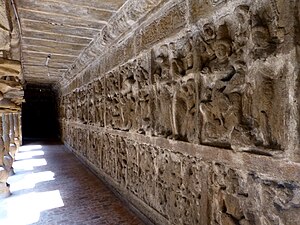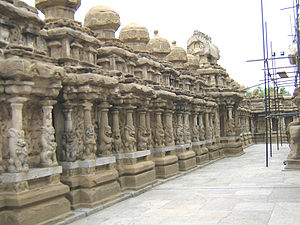Pallava dynasty
Pallava dynasty | |||||||||||||||
|---|---|---|---|---|---|---|---|---|---|---|---|---|---|---|---|
| 275 CE–897 CE | |||||||||||||||
![Pallava territories during Narasimhavarman I c. 645. This includes the Chalukya territories occupied by the Pallavas.[1]](https://upload.wikimedia.org/wikipedia/commons/thumb/c/c0/Pallava_territories.png/250px-Pallava_territories.png) Pallava territories during Narasimhavarman Ic.645. This includes the Chalukya territories occupied by the Pallavas.[1] | |||||||||||||||
| Status | Dynasty | ||||||||||||||
| Capital | Kanchipuram | ||||||||||||||
| Common languages | |||||||||||||||
| Religion | Hinduism,Jainism,Buddhism | ||||||||||||||
| Government | Monarchy | ||||||||||||||
• 275–300 | Simhavarman I | ||||||||||||||
• 885–897 | Aparajitavarman | ||||||||||||||
| Historical era | Classical India | ||||||||||||||
• Established | 275 CE | ||||||||||||||
• Disestablished | 897 CE | ||||||||||||||
| |||||||||||||||
| Today part of | India Sri Lanka[3] | ||||||||||||||
| Pallava Monarchs(200s–800s CE) | |
|---|---|
| Virakurcha | (??–??) |
| Vishnugopa I | (??–??) |
| Vishnugopa II | (??–??) |
| Simhavarman III | (??–??) |
| Simhavishnu | 575–600 |
| Mahendravarman I | 600–630 |
| Narasimhavarman I | 630–668 |
| Mahendravarman II | 668–670 |
| Paramesvaravarman I | 670–695 |
| Narasimhavarman II | 695–728 |
| Paramesvaravarman II | 728–731 |
| Nandivarman II | 731–795 |
| Dantivarman | 795–846 |
| Nandivarman III | 846–869 |
| Nrpatungavarman | 869–880 |
| Aparajitavarman | 880–897 |
ThePallava dynastyexisted from 275 CE to 897 CE, ruling a significant portion ofthe Deccan,also known asTondaimandalam.The Pallavas played a crucial role in shaping in particular southern Indian history and heritage.[4][5]The dynasty rose to prominence after the downfall of theSatavahana Empire,whom they had formerly served asfeudatories.[6][7]
The Pallavas became a majorsouthern Indianpower during the reign ofMahendravarman I(600–630 CE) andNarasimhavarman I(630–668 CE), and dominated the southernTelugu regionand the northern parts of theTamilregion for about 600 years, until the end of the 9th century. Throughout their reign, they remained in constant conflict with both theChalukyasofVatapito the north, and the Tamil kingdoms ofCholaandPandyasto their south. The Pallavas were finally defeated by theCholarulerAditya Iin the 9th century CE.[8]
The Pallavas are most noted for their patronage of Hindu Vaishnava temple architecture, the finest example being theShore Temple,aUNESCO World Heritage SiteinMamallapuram.Kancheepuramserved as the capital of the Pallava kingdom. The dynasty left behind magnificent sculptures and temples, and are recognized to have established the foundations of medieval southern Indian architecture, which some scholars believe the ancient Hindu treatiseManasarainspired.[9]They developed thePallava script,from whichGranthaultimately took form. This script eventually gave rise to several other Southeast Asian scripts suchKhmer.The Chinese travellerXuanzangvisitedKanchipuramduring Pallava rule and extolled their benign rule.
Etymology
[edit]The word Pallava means a creeper or branch in Sanskrit.[10][11][12]Pallava also means arrow or spruce in Tamil.[13][14][15]
Origins
[edit]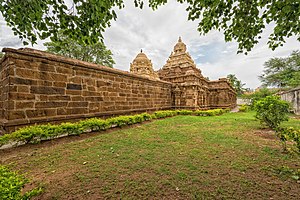

The origins of the Pallavas have been debated by scholars.[16]The available historical materials include three copper-plate grants of Sivaskandavarman in the first quarter of the 4th century CE, all issued fromKanchipurambut found in various parts ofAndhra Pradesh,and another inscription ofSimhavarman Ihalf century earlier in thePalnadu(Pallava Nadu) area of the westernGuntur district.[17][18]All the early documents are inPrakrit,and scholars find similarities in paleography and language with theSatavahanasand theMauryas.[19]Their early coins are said to be similar to those of Satavahanas.[20]Two main theories regarding the origins of the Pallavas have emerged based on available historical data. The first theory suggests that the Pallavas were initially subordinate to the Satavahanas, a ruling dynasty in the Andhradesa region (north of the Penna River in modern-dayAndhra Pradesh[21]). According to this theory, the Pallavas later expanded their influence southward, eventually establishing their power in Kanchi (modern-dayKanchipuram). The second theory proposes that the Pallavas originated in Kanchi itself, where they initially rose to prominence. From there, they expanded their dominion northward, reaching as far as the Krishna River. Another theory posits that the Pallavas were descendants of Chola PrinceIlandiraiyanand had their roots inTondaimandalam,the region around Kanchi. These theories provide different perspectives on the Pallavas' early history and territorial expansion, but the exact origins of the Pallava dynasty continue to be a subject of debate among historians.
The proponents of the Andhra origin theory includeS. Krishnaswami AiyangarandK. A. Nilakanta Sastri.They believe that Pallavas were originally feudatories of the Satavahanas in the south-eastern part of their empire who became independent when the Satavahana power declined.[22]They are seen to be "strangers to the Tamil country", unrelated to the ancient lines of Cheras, Pandyas and Cholas. Since Simhavarman's grant bears no regal titles, they believe that he might have been a subsidiary to theAndhra Ikshvakuswho were in power inAndhradesaat that time. In the following half-century, the Pallavas became independent and expanded up to Kanchi.[23][24]
S. Krishnaswami Aiyengaralso speculates that the Pallavas were natives ofTondaimandalamand the name Pallava is identical with the word Tondaiyar.[25]CholaPrinceIlandiraiyanis traditionally regarded as the founder of the Pallava dynasty.[26]Ilandiraiyan is referred to in the literature of theSangam periodsuch as thePathupattu.In the Sangam epicManimekalai,he is depicted as the son ofCholaking Killi and the Naga princess Pilivalai, the daughter of king Valaivanan ofManipallavam.
Another theory is propounded by historians R. Sathianathaier[16]andD. C. Sircar,[27]with endorsements byHermann Kulke,Dietmar Rothermund[28]andBurton Stein.[29]Sircar points out that the family legends of the Pallavas speak of an ancestor descending fromAshwatthama,the legendary warrior ofMahabharata,and his union with aNagaprincess. According toPtolemy,theAruvanaduregion between the northern and southern Penner rivers (PennaandPonnaiyar[30][31]) was ruled by a king Basaronaga around 140 CE. By marrying into thisNagafamily, the Pallavas would have acquired control of the region near Kanchi.[27]While Sircar allows that Pallavas might have been provincial rulers under the later Satavahanas with a partial northern lineage, Sathianathaier sees them as natives ofTondaimandalam(the core region of Aruvanadu). He argues that they could well have adopted northern Indian practices under the MauryanAsoka's rule. He relates the name "Pallava" toPulindas,whose heritage is borne by names such as "Pulinadu" and "Puliyurkottam" in the region.[32]
According toSir H. A. Stuartthe Pallavas wereKurumbasandKurubastheir modern representatives.[33]This is supported by Marathi historianR. C. Dherewho stated that Pallavas were originally pastoralists that belonged to Kuruba lineages.[34]The territory of Pallavas was bordered by theCoromandel Coastalong present Tamil Nadu and southern Andhra Pradesh. Out of the coins found here, the class of gold and silver coins belonging to the 2nd-7th century CE period contain the Pallava emblem, the maned lion, together withKannadaorSanskritinscription which showed that the Pallavas used Kannada too in their administration along with Prakrit, Sanskrit and Tamil.[35]
According toC. V. Vaidya,the Pallavas were Maharashtrian Aryans who spokeMaharashtri Prakritfor centuries and hence retained it even in the midst of surrounding Dravidian languages. They may even be said to have been 'Marathas' for their name was said to be still preserved in the Maratha family name of 'Pālave' (which is just Prakrit form of Pallava). And a further corroboration is that the gotra of the Pālave Maratha family isBharadwaja,same as the one which Pallavas have attributed to themselves in their records.[36]
Overlaid on these theories is another hypothesis of Sathianathaier which claims that "Pallava" is a derivative ofPahlava(the Sanskrit term for Parthians). According to him, partial support for the theory can be derived from a crown shaped like an elephant's scalp depicted on some sculptures, which seems to resemble the crown ofDemetrius I.[16]
Rivalries
[edit]With Cholas
[edit]The Pallavas captured Kanchi from theCholasas recorded in the Velurpalaiyam Plates, around the reign of the fifth king of the Pallava line Kumaravishnu I.[citation needed]Thereafter Kanchi figures in inscriptions as the capital of the Pallavas. The Cholas drove the Pallavas away from Kanchi in the mid-4th century, in the reign ofVishnugopa,the tenth king of the Pallava line.[citation needed]The Pallavas re-captured Kanchi from theKalabhrasin the mid-6th century,[citation needed]possibly in the reign ofSimhavishnu,[citation needed]the fourteenth king of the Pallava line, whom the Kasakudi plates state as "the lion of the earth". Thereafter the Pallavas held on toKanchiuntil the 9th century, until the reign of their last king,Vijaya-Nripatungavarman.[39]
With Kadambas
[edit]The Pallavas were in conflict with major kingdoms at various periods of time. A contest for political supremacy existed between the early Pallavas and theKadambas.Numerous Kadamba inscriptions provide details of Pallava-Kadamba hostilities.[40]
With Kalabhras
[edit]During the reign of Vishnugopavarman II (approx. 500–525), political convulsion engulfed the Pallavas due to theKalabhrainvasion of the Tamil country. Towards the close of the 6th century, the Pallava Simhavishnu stuck a blow against the Kalabhras. The Pandyas followed suit. Thereafter the Tamil country was divided between the Pallavas in the north withKanchipuramas their capital, and Pandyas in the south withMaduraias their capital.[41]
Birudas
[edit]The royal custom of using a series of descriptive honorific titles,Birudas,was particularly prevalent among the Pallavas. The Birudas of Mahendravarman I are in Sanskrit, Tamil and Telugu. The Telugu Birudas show Mahendravarman's involvement with the Andhra region continued to be strong at the time he was creating his cave-temples in the Tamil region. The suffix "Malla" was used by the Pallava rulers.[42]Mahendravarman I used the Biruda,Shatrumalla,"a warrior who overthrows his enemies", and his grandson Paramesvara I was calledEkamalla"the sole warrior or wrestler". Pallava kings, presumably exalted ones, were known by the titleMahamalla( "great wrestler" ).[43]
Languages used
[edit]
Pallava inscriptions have been found inTamil, PrakritandSanskrit.
Tamil was main language used by the Pallavas in their inscriptions, though a few records continued to be in Sanskrit.[44]At the time of the time ofParamesvaravarman I,the practice came into vogue of inscribing a part of the record in Sanskrit and the rest in Tamil. Almost all the copper plate records, viz., Kasakudi, Tandantottam, Pattattalmangalm, Udayendiram and Velurpalaiyam are composed both in Sanskrit and Tamil.[44]
Many Pallava royal inscriptions were in Sanskrit or Prakrit, considered the official languages. Similarly, inscriptions found in Andhra Pradesh and Karnataka State are in Sanskrit and Prakrit.[45]Sanskrit was widely used bySimhavishnuandNarasimhavarman IIin literature. The phenomenon of using Prakrit as official languages in which rulers left their inscriptions and epigraphies continued till the 6th century. It would have been in the interest of the ruling elite to protect their privileges by perpetuating their hegemony of Prakrit in order to exclude the common people from sharing power (Mahadevan 1995a: 173–188). The Pallavas in their Tamil country used Tamil and Sanskrit in their inscriptions.[46][44]
Writing system
[edit]Under the Pallava dynasty, a unique form ofGrantha script,a descendant of Pallava script which is a type ofBrahmic script,was used. Around the 6th century, it was exported eastwards and influenced the genesis of almost all Southeast Asian scripts.
Religion
[edit]Pallavas were followers of Hinduism and made gifts of land to gods and Brahmins. In line with the prevalent customs, some of the rulers performed theAswamedhaand otherVedic sacrifices.[47]They were, however, tolerant of other faiths. The Chinese monkXuanzangwho visitedKanchipuramduring the reign of Narasimhavarman I reported that there were 100 Buddhist monasteries, and 80 Hindu temples in Kanchipuram.[48]The semi-legendary founder ofZen Buddhism,Bodhidharma,is in an Indian tradition regarded to be the third son of a Pallava king.[49]
Pallava architecture
[edit]

The Pallavas were instrumental in the transition from rock-cut architecture to stone temples. The earliest examples of Pallava constructions are rock-cut temples dating from 610 to 690 and structural temples between 690 and 900. A number of rock-cut cave temples bear the inscription of the Pallava king, Mahendravarman I and his successors.[50][51][52][53]
Among the accomplishments of the Pallava architecture are the rock-cut temples atMamallapuram.There are excavated pillared halls and monolithic shrines known asRathasin Mahabalipuram. Early temples were mostly dedicated toShiva.The Kailasanatha temple inKanchipuramand theShore Templebuilt byNarasimhavarman II,rock cut temple inMahendravadiby Mahendravarman are fine examples of the Pallava style temples.[54]The temple ofNalanda GedigeinKandy,Sri Lankais another. The famousTondeswaram templeofTenavaraiand the ancientKoneswaram templeofTrincomaleewere patronised and structurally developed by the Pallavas in the 7th century.[52][55]
Pallava society
[edit]The Pallava period beginning with Simhavishnu (575 CE – 900 CE) was a transitional stage in southern Indian society with monument building, foundation of devotional (bhakti) sects ofAlvarsandNayanars,the flowering of rural Brahmanical institutions of Sanskrit learning, and the establishment ofchakravartinmodel of kingship over a territory of diverse people; which ended the pre-Pallavan era of territorially segmented people, each with their culture, under a tribal chieftain.[56]While a system of ranked relationship among groups existed in theclassical period,the Pallava period extolled ranked relationships based on ritual purity as enjoined by theshastras.[57]Burton distinguishes between thechakravatinmodel and thekshatriyamodel, and likens kshatriyas to locally based warriors with ritual status sufficiently high enough to share with Brahmins; and states that in south India the kshatriya model did not emerge.[57]As per Burton, south India was aware of the Indo-Aryanvarnaorganised society in which decisive secular authority was vested in thekshatriyas;but apart from the Pallava, Chola and Vijayanagar line of warriors which claimedchakravartinstatus, only few locality warrior families achieved the prestigious kin-linked organisation of northern warrior groups.[57]
Chronology
[edit]Sastri chronology
[edit]The earliest documentation on the Pallavas is the three copper-plate grants, now referred to as theMayidavolu(fromMaidavoluvillage inGuntur districtofAndhra Pradesh),Hirehadagali(from Hire Hadagali ofKarnataka) and theBritish Museumplates (Durga Prasad, 1988) belonging to Skandavarman I and written inPrakrit.[58]Skandavarman appears to have been the first great ruler of the early Pallavas, though there are references to other early Pallavas who were probably predecessors of Skandavarman.[59]Skandavarman extended his dominions from theKrishnain the north to thePennarin the south and to theBellarydistrict in the West. He performed theAswamedhaand other Vedic sacrifices and bore the title of "Supreme King of Kings devoted to dharma".[58]
The Hirahadagali copper plate (Bellary District) record in Prakrit is dated in the eighth year of Sivaskanda Varman to 283 CE and confirms the gift made by his father who is described merely as "Bappa-deva" (revered father) or Boppa. It will thus be clear that this dynasty of the Prakrit charters beginning with "Bappa-deva" were the historical founders of the Pallava dominion in southern India.[60][61]
The Hirahadagalli Plates were found in Hirehadagali,Bellary districtand is one of the earliest copper plates inKarnatakaand belongs to the reign of early Pallava ruler Shivaskanda Varma. Pallava King Sivaskandavarman of Kanchi of the early Pallavas ruled from 275 to 300 CE, and issued the charter in 283 CE in the eighth year of his reign.
As per the Hirahadagalli Plates of 283 CE, Pallava King Sivaskandavarman granted an immunity viz the garden of Chillarekakodumka, which was formerly given by Lord Bappa to the Brahmins, freeholders of Chillarekakodumka and inhabitants of Apitti. Chillarekakodumka has been identified by some as ancient village Chillarige in Bellary, Karnataka.[60]
In the reign ofSimhavarman II,who ascended the throne in 436, the territories lost to theVishnukundinsin the north up to the mouth of the Krishna were recovered.[62]The early Pallava history from this period onwards is furnished by a dozen or so copper-plate grants inSanskrit.They are all dated in the regnal years of the kings.[47]
The following chronology was composed from these charters byNilakanta Sastriin hisA History of South India:[47]
Early Pallavas
[edit]| Part ofa serieson |
| History of Tamil Nadu |
|---|
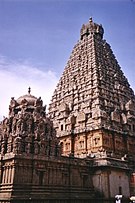 |
| Part ofa serieson |
| Andhra PradeshandTelangana |
|---|
 |
| History and Kingdoms |
- Simhavarman I(275–300)
- Shivskandvarman (unknown)
- Vijayskandavarman (unknown)
- Skandavarman (unknown)
- Vishnugopa I(350–355)
- Kumaravishnu I (350–370)
- Skandavarman II (370–385)
- Viravarman (385–400)
- Skandavarman III (400–436)
- Simhavarman II(436–460)
- Skandavarman IV (460–480)
- Nandivarman I (480–510)
- Kumaravishnu II (510–530)
- Buddhavarman (530–540)
- Kumaravishnu III (540–550)
- Simhavarman III(550–560)
Later Pallavas
[edit]
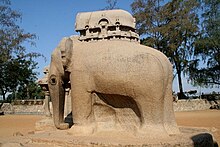
The incursion of theKalabhrasand the confusion in the Tamil country was broken by thePandyaKadungonand the PallavaSimhavishnu.[63]Mahendravarman Iextended the Pallava Kingdom and was one of the greatest sovereigns. Some of the most ornate monuments and temples in southern India, carved out of solid rock, were introduced under his rule. He also wrote the playMattavilasa Prahasana.[64]
The Pallava kingdom began to gain both in territory and influence and were a regional power by the end of the 6th century, defeating kings ofCeylonand mainland Tamilakkam.[65]Narasimhavarman IandParamesvaravarman Istand out for their achievements in both military and architectural spheres.Narasimhavarman IIbuilt theShore Temple.
- Simhavishnu(575–600)[64]
- Mahendravarman I(600–630)[64]
- Narasimhavarman I(Mamalla) (630–668)[64]
- Mahendravarman II(668–672)
- Paramesvaravarman I(670–695)[64]
- Narasimhavarman II(Raja Simha) (695–722)[64]
- Paramesvaravarman II(705–710)
Later Pallavas of the Kadava Line
[edit]The kings that came after Paramesvaravarman II belonged to the collateral line of Pallavas and were descendants of Bhimavarman, the brother of Simhavishnu. They called themselves asKadavas,Kadavesa and Kaduvetti. Hiranyavarman, the father of Nandivarman Pallavamalla is said to have belonged to the Kadavakula in epigraphs.[66]Nandivarman II himself is described as "one who was born to raise the prestige of the Kadava family".[67]
- Nandivarman II(Pallavamalla) (732–796) son of Hiranyavarman of Kadavakula[66][64]
- Dantivarman(795–846)[64]
- Nandivarman III(846–869)[64]
- Aparajitavarman(879–897)[64]
Aiyangar chronology
[edit]According to the available inscriptions of the Pallavas, historianS. Krishnaswami Aiyangarproposes the Pallavas could be divided into four separate families or dynasties; some of whose connections are known and some unknown.[68]Aiyangar states
We have a certain number of charters in Prakrit of which three are important ones. Then follows a dynasty which issued their charters in Sanskrit; following this came the family of the great Pallavas beginning with Simha Vishnu; this was followed by a dynasty of the usurper Nandi Varman, another great Pallava. We are overlooking for the present the dynasty of the Ganga-Pallavas postulated by the Epigraphists. The earliest of these Pallava charters is the one known as the Mayidavolu 1 (Guntur district) copper-plates.
Based on a combination of dynastic plates and grants from the period, Aiyangar proposed their rule thus:
Early Pallavas
[edit]- Bappadevan, chola prince (250–275) – married a Naga of Mavilanga (Kanchi)[citation needed]–The Great Founder of a Pallava lineage
- Shivaskandavarman I (275–300)
- Simhavarman (300–320)
- Bhuddavarman (320–335)
- Bhuddyankuran (335–340)
Middle Pallavas
[edit]- Visnugopa (340–355) (Yuvamaharaja Vishnugopa)
- Kumaravisnu I (355–370)
- Skanda Varman II (370–385)
- Vira Varman (385–400)
- Skanda Varman III (400–435)
- Simha Varman II (435–460)
- Skanda Varman IV (460–480)
- Nandi Varman I (480–500)
- Kumaravisnu II (c.500–510)
- Buddha Varman (c.510–520)
- Kumaravisnu III (c.520–530)
- Simha Varman III (c.530–537)
Later Pallavas
[edit]- Simhavishnu(537–570)
- Mahendravarman I(571–630)
- Narasimhavarman I(Mamalla) (630–668)
- Mahendravarman II(668–672)
- Paramesvaravarman I(672–700)
- Narasimhavarman II(Raja Simha) (700–727)
- Paramesvaravarman II(705–710)
Later Pallavas of the Kadava Line
[edit]- Nandivarman II(Pallavamalla) (732–796) son of Hiranyavarman of Kadavakula[66]
- Dantivarman(775–825)
- Nandivarman III(825–869)
- Nirupathungan (869–882)
- Aparajitavarman(882–896)
Genealogy of Māmallapuram Praśasti
[edit]The genealogy of Pallavas mentioned in theMāmallapuram Praśastiis as follows:[43]
- Vishnu
- Brahma
- Unknown / undecipherable
- Unknown / undecipherable
- Bharadvaja
- Drona
- Ashvatthaman
- Pallava
- Unknown / undecipherable
- Unknown / undecipherable
- Simhavarman I (c.275)
- Unknown / undecipherable
- Unknown / undecipherable
- Simhavarman IV (436–c.460)
- Unknown / undecipherable
- Unknown / undecipherable
- Skandashishya
- Unknown / undecipherable
- Unknown / undecipherable
- Simhavisnu (c.550–585)
- Mahendravarman I (c.571–630)
- Maha-malla Narasimhavarman I (630–668)
- Unknown / undecipherable
- Paramesvaravarman I (669–690)
- Rajasimha Narasimhavaram II (690–728)
- Unknown / undecipherable
- Pallavamalla Nandivarman II (731–796)
- Unknown / undecipherable
- Nandivarman III (846–869)
Relation with the Cholas
[edit]According to historianS. Krishnaswami Aiyengar,the Pallavas were natives ofTondaimandalamand the name Pallava is identical with the word Tondaiyar.[25]CholaPrinceIlandiraiyanis traditionally regarded as the founder of the Pallava dynasty.[26]Ilandiraiyan is referred to in the literature of theSangam periodsuch as thePathupattu.In the Sangam epicManimekalai,he is depicted as the son ofCholaking Killi and the Naga princess Pilivalai, the daughter of king Valaivanan ofManipallavam.When the boy grew up the princess wanted to send her son to the Chola kingdom. So she entrusted the prince to a merchant who dealt in woolen blankets called Kambala Chetty when his ship stopped in the island of Manipallavam. During the voyage to the Chola kingdom, the ship was wrecked due to rough weather and the boy was lost. He was later found washed ashore with a Tondai twig (creeper) around his leg. So he came to be called Tondaiman Ilam Tiraiyan meaningthe young one of the seas or waves.When he grew up the northern part of the Chola kingdom was entrusted to him and the area he governed came to be calledTondaimandalamafter him.He was a poet himself and four of his songs are extant even today.[69]He ruled fromTondaimandalamand was known as "Tondaman."[26]
Other relationships
[edit]Pallava royal lineages were influential in theold kingdom of Kedahof the Malay Peninsula under Rudravarman I,ChampaunderBhadravarman Iand the Kingdom of theFunanin Cambodia.[70]Some historians have claimed the present Pallar caste are descendants of the Pallavas who ruled the Andhra and Tamil countries between the 6th and 9th centuries.[citation needed]Tamil scholar M. Srinivasa Iyengar claimed claimed the Pallars were one of the communities who served often in Pallava armies.[71]
The similarity of the name ending "-varman"of Pallava rulers with that ofHindu kingsduring theHindu/Buddhist eraofIndonesiasuch as kingMulavarmanof theKutai Martadipura Kingdom,kingPurnawarmanof theTarumanagarakingdom, kingAdityawarmanof theMalayapurakingdom, etc. has been commented upon by historians since discovery.[72]There have been possible high relations and connections of the Hindu kingdoms of Indonesia with the Pallava dynasty and other Hindu and Buddhist kingdoms of India back then.
List of feudatories
[edit]See also
[edit]Notes
[edit]- ^Schwartzberg, Joseph E. (1978).A Historical atlas of South Asia.Chicago: University of Chicago Press. p. 146, map XIV.2 (e).ISBN0226742210.
- ^Vaidya C.V., Medieval History of Hindu India Volume 1, pg.281
- ^Ancient Jaffna: Being a Research Into the History of Jaffna from Very Early Times to the Portuguese Period, C. Rasanayagam, p.241, Asian Educational Services 1926
- ^Sen, Aloka Parasher (28 February 2021),"Defining the Early Deccan: A Re-think*",Settlement and Local Histories of the Early Deccan,Routledge, pp. 39–60,doi:10.4324/9781003155607-2,ISBN978-1-003-15560-7,S2CID229492642,retrieved14 May2023
- ^Francis, Emmanuel (28 October 2021)."Pallavas".The Encyclopedia of Ancient History:1–4.doi:10.1002/9781119399919.eahaa00499.ISBN978-1-119-39991-9.S2CID240189630.
- ^The journal of the Numismatic Society of India, Volume 51, p.109
- ^Alī Jāvīd and Tabassum Javeed. (2008). World heritage monuments and related edifices in India, p.107[1]
- ^Gabriel Jouveau-Dubreuil,The Pallavas,Asian Educational Services, 1995 - Art, Indic - 86 pages, p. 83
- ^Past and present: Manasara (English translation),14 May 2020
- ^South Indian History Congress. (17 February 1980),Proceedings of the First Annual Conference,vol. 1, The Congress and The Madurai Kamaraj University Co-op Printing Press
- ^N. Ramesan,Copper Plate Inscriptions of the State Museum, Volume 3, Issues 28-29 of Arch. series,Government of Andhra Pradesh, 1960, p. 55
- ^Gautam Sengupta, Suchira Roychoudhury, Sujit Som,Past and present: ethnoarchaeology in India,Pragati Publications in collaboration with Centre for Archaeological Studies and Training, Eastern India, 2006, p. 133
{{citation}}:CS1 maint: multiple names: authors list (link) - ^ValaiTamil."Pallava, பல்லவம் Tamil Agaraathi, tamil-english dictionary, english words, tamil words".ValaiTamil.Retrieved2 August2022.
- ^"Pallavas".tamilnation.org.Retrieved2 August2022.
- ^"About Tamil Nadu | Tamil Nadu Government Portal".tn.gov.in.Retrieved2 August2022.
- ^abcSathianathaier 1970,pp. 255–256.
- ^Aiyangar & Nilakanta Sastri 1960,pp. 315–316[missing long citation]:"This view, which till recently was no more than an intelligent guess, seems to gain support from a Prakrit Brahmi inscription recently discovered in the Palnad taluk of the Guntur district. In spite of its mutilated condition, it clearly mentions SihavammaSimhavarman Iof thePalavadynasty and Bharadaya gotta... This is the earliest Pallava inscription so far known. "
- ^Rama Rao 1967,pp. 47–48:"The Manchikallu Prakrt inscription mentions a Simhavamma or Simhavarman of the Pallava family and the Bharadvaja gotra and registers gifts made by him after performingSantiandSvastyayanafor his victory and increase of strength. "
- ^Aiyangar & Nilakanta Sastri 1960,pp. 315–316.
- ^Subramanian, K. R. (1989) [1932],Buddhist Remains in Andhra and the History of Andhra Between 225 and 610 A.D.,Asian Educational Services, p. 71,ISBN978-81-206-0444-5
- ^Gopalachari, K. (1957),"The Satavahana Empire",inK. A. Nilakanta Sastri(ed.),A Comprehensive History of India, II: The Mauryas and Satavahanas 325 SC.-AD 300,Calcutta: Indian History Congress/Orient Longman, pp. 296–297, note 1:"The Andhradesa of our period was limited in the north by Kalinga and in the east by the sea; in the south it did not extend far beyond the northern part of the Nellore district (the PallavaKarmarashtra), in the west it extended far into the interior. "
- ^Aiyangar & Nilakanta Sastri 1960,pp. 314–316: "There is much in favour of the thesis that the Pallavas rose into prominence in the service of the Satavahanas in the south-eastern division of their empire, and attained independence when that power declined."
- ^Aiyangar & Nilakanta Sastri 1960,pp. 314–316.
- ^Sathianathaier 1970,p. 256: "S. Krishnaswami Aiyangar regards the Pallavas as the feudatories of the Satavahanas—officers and governors of the south-eastern part of their empire, equates the term Pallava with the terms Tondaiyar and Tondaman (people and rulers of Tonda-mandalam), and says that, after the fall of the Satavahana Empire, those feudatories 'founded the new dynasty of the Pallavas, as distinct from the older chieftains, the Tondamans of the region.'"
- ^abT. V. Mahalingam.Kāñcīpuram in early South Indian history.Asia Pub. House, 1969. p. 22.
- ^abcRamaswamy 2007,p. 80.
- ^abSircar 1970,pp. 275–276.
- ^Kulke & Rothermund 2004,p. 120.
- ^Stein, Burton (2016). "Book Reviews: Kancipuram in Early South Indian History, by T. V. Mahalingam (Madras: Asia Publishing House, 1969), pp. vii-243".The Indian Economic & Social History Review.7(2): 317–321.doi:10.1177/001946467000700208.ISSN0019-4646.S2CID144817627.:"...the rather well argued and plausible stand that the Palavas were indigenous to the central Tamil plain, Tondaimandalam..."
- ^Sircar, Dines Chandra (1935),The Early Pallavas,Calcutta: Jitendra Nath De, pp. 5–6:"There can hardly be any doubt that this Aruvanadu between the Northern and Southern Pennars is the Arouarnoi of Ptolemy's Geography. This Arouarnoi is practically the same as the Kanci-mandala, i.e. the district round Kanci."
- ^Aiyangar, S. K. (1928),"Introduction",in R. Gopalan (ed.),History of the Pallavas of Kanchi,University of Madras, pp. xi–xii:"... River South Pennar where began the division known asAruvānādu,which extended northwards along the coast almost as far as the Northern Pennar. "
- ^Sathianathaier 1970,pp. 256–257.
- ^H.V. Nanjundayya; L.K. Anathakrishna (1988).The Mysore tribes and castes, Vol 4.Mysore, Mysore University. p. 30.OCLC830766457.
The following extract from the Census Report of Madras for 1891, gives them a higher status than they usually claim:— "They (the Kurubas) are the modern representatives of the ancient Kurumbas or Pallavas, who were once so powerful, throughout South India, but very little trace of their greatness now remains.
- ^Dhere, Ramchandra Chintaman(2011).Rise of a Folk God: Vitthal of Pandharpur, South Asia Research.Feldhaus, Anne (trans.). Oxford University Press. p. 243.ISBN978-0-19977-764-8.
The history of South India shows clearly that all the southern royal dynasties who arose from pastoralist, cowherd groups gained Kshatriya status by claiming to be Moon lineage Kshatriyas, by taking Yadu as their ancestor, and by continually keeping alive their pride in being 'Yadavas'. Many dynasties in South India, from the Pallavas to the Yadavarayas, were originally members of pastoralist, cowherd groups and belonged to Kuruba lineages.
- ^Rapson, Edward James (1897).Indian Coins-Numismatics.K.J. Trübner. p. 37.
- ^Vaidya C.V., History of Medieval Hindu India, pg.281
- ^Schwartzberg, Joseph E. (1978).A Historical atlas of South Asia.Chicago: University of Chicago Press. p. 25, 145.ISBN0226742210.
- ^Agrawal, Ashvini (1989)."Chapter II: THE POLITICAL CONDITION OF INDIA BEFORE THE RISE OF GUPTAS - EASTERN INDIA".Rise and Fall of the Imperial Guptas.New Delhi:Motilal Banarsidass.pp. 60, 61.ISBN81-208-0592-5.
- ^Rev. H Heras, SJ (1931) Pallava Genealogy: An attempt to unify the Pallava Pedigrees of the Inscriptions, Indian Historical Research Institute
- ^KR Subramanian. (1989). Buddhist remains in Āndhra and the history of Āndhra between 224 & 610 A.D, p.106-109
- ^Sen, Sailendra Nath (1999),Ancient Indian History And Civilization,New Age International, p. 445,ISBN9788122411980
- ^Marilyn Hirsh (1987) Mahendravarman I Pallava: Artist and Patron of Māmallapuram, Artibus Asiae, Vol. 48, Number 1/2 (1987), pp. 109-130
- ^abRabe, Michael D (1997). "The Māmallapuram Praśasti: A Panegyric in Figures".Artibus Asiae.57(3/4): 189–241.doi:10.2307/3249929.JSTOR3249929.
- ^abcVenkayya, V(April 1911). "Velurpalaiyam Plates of Nandivarman III".The Journal of the Royal Asiatic Society of Great Britain and Ireland.43:521–524.doi:10.1017/S0035869X00041617.JSTOR25189883.S2CID163316246.
- ^Rajan K. (Jan-Feb 2008). Situating the Beginning of Early Historic Times in Tamil Nadu: Some Issues and Reflections, Social Scientist, Vol. 36, Number 1/2, pp. 40-78
- ^Heras,p 38
- ^abcNilakanta Sastri,A History of South India,p.92
- ^Kulke and Rothermund, pp121–122
- ^Hemanth, Ungal Anban (3 January 2021)."History of Bodhidharma — Mysteries & Secrets (Indian Pallava Prince)".Lessons from History.Retrieved18 May2022.
- ^Nilakanta Sastri, pp412–413
- ^James G. Lochtefeld (2002),The Illustrated Encyclopedia of Hinduism: A-M,The Rosen Publishing Group, p. 399,ISBN978-0-8239-3179-8
- ^ab"Group of Monuments at Mahabalipuram".UNESCO.org.Retrieved23 October2012.
- ^"Advisory body evaluation"(PDF).UNESCO.org.Retrieved23 October2012.
- ^Nilakanta Sastri, p139
- ^Group of Monuments at Mahabalipuram, Dist. KanchipuramArchived29 May 2018 at theWayback Machine,Archaeological Survey of India (2014)
- ^Burton Stein (1980),Peasant state and society in medieval South India,Oxford University Press, pp. 63–64
- ^abcBurton Stein (1980),Peasant state and society in medieval South India,Oxford University Press, p. 70
- ^abNilakanta Sastri,A History of South India,p.91
- ^Nilakanta Sastri,A History of South India,p.91–92
- ^abAiyangar, S. Krishnaswami (2003),"Early History Of The Pallavas",Some Contributions Of South India To Indian Culture,Cosmo Publications (15 July 2003),ISBN978-8170200062
- ^Moraes, George M. (1995),The Kadamba Kula: A History of Ancient and Mediaeval Karnataka,Asian Educational Services, p. 6,ISBN9788120605954
- ^Arunkumar, R. (2014),"Political History of Ancient South India"(PDF),Caste system in ancient South India,Gulbarga University/Shodhganga,hdl:10603/28091
- ^Kulke and Rothermund, p.120
- ^abcdefghijSen, Sailendra (2013),A Textbook of Medieval Indian History,Primus Books, pp. 41–42,ISBN978-9-38060-734-4
- ^Kulke and Rothermund, p111
- ^abcV. Ramamurthy,History of Kongu, Volume 1,International Society for the Investigation of Ancient Civilization, 1986, p. 172
- ^Eugen Hultzsch,South Indian Inscriptions, Volume 12,Manager of Publications, 1986, p. viii
- ^S.Krishnaswami Aiyangar. Some Contributions Of South India To Indian Culture.Early History of the Pallavas
- ^Sastri 1961,p. 126.
- ^Cœdès, George (1 January 1968),The Indianized States of South-East Asia,University of Hawaii Press,ISBN9780824803681
- ^Venkatasubramanian 1986,p. 35.
- ^VOGEL, J. Ph. (1918). "The Yupa Inscriptions of King Mulavarman, from Koetei (East Borneo)".Bijdragen tot de Taal-, Land- en Volkenkunde van Nederlandsch-Indië.74(1/2): 167–232.ISSN1383-5408.JSTOR20769898.
References
[edit]- Aiyangar, S. K.;Nilakanta Sastri, K. A.(1960),"The Pallavas",in R. C. Majumdar; K. K. Dasgupta (eds.),A Comprehensive History of India, Volume III, Part 1: A.D. 300–985,New Delhi: Indian History Congress/People's Publishing House
- Avari, Burjor (2007),India: The Ancient Past,New York: Routledge
- Hermann, Kulke; Rothermund D (2001) [2000],A History of India,Routledge,ISBN0-415-32920-5
- Kulke, Hermann; Rothermund, Dietmar (2004),A History of India(Fourth ed.), Routledge,ISBN9780415329194
- Minakshi, Cadambi(1938),Administration and Social Life Under the Pallavas,Madras: University of Madras
- Prasad, Durga (1988),History of the Andhras up to 1565 A.D.,Guntur, India: P.G. Publishers
- Sathianathaier, R. (1970) [first published 1954],"Dynasties of South India",in Majumdar, R. C.; Pusalkar, A. D. (eds.),The Classical Age,History and Culture of Indian People (Third ed.), Bharatiya Vidya Bhavan, pp. 255–275
- Sircar, D. C. (1970) [first published 1954],"Genealogy and Chronology of the Pallavas",in Majumdar, R. C.; Pusalkar, A. D. (eds.),The Classical Age,History and Culture of Indian People (Third ed.), Bharatiya Vidya Bhavan, pp. 275–290
- Raghava Iyengar, R (1949),Perumbanarruppatai, a commentary,Chidambaram, India: Annamalai University Press
External links
[edit] Media related toPallava Empireat Wikimedia Commons
Media related toPallava Empireat Wikimedia Commons

